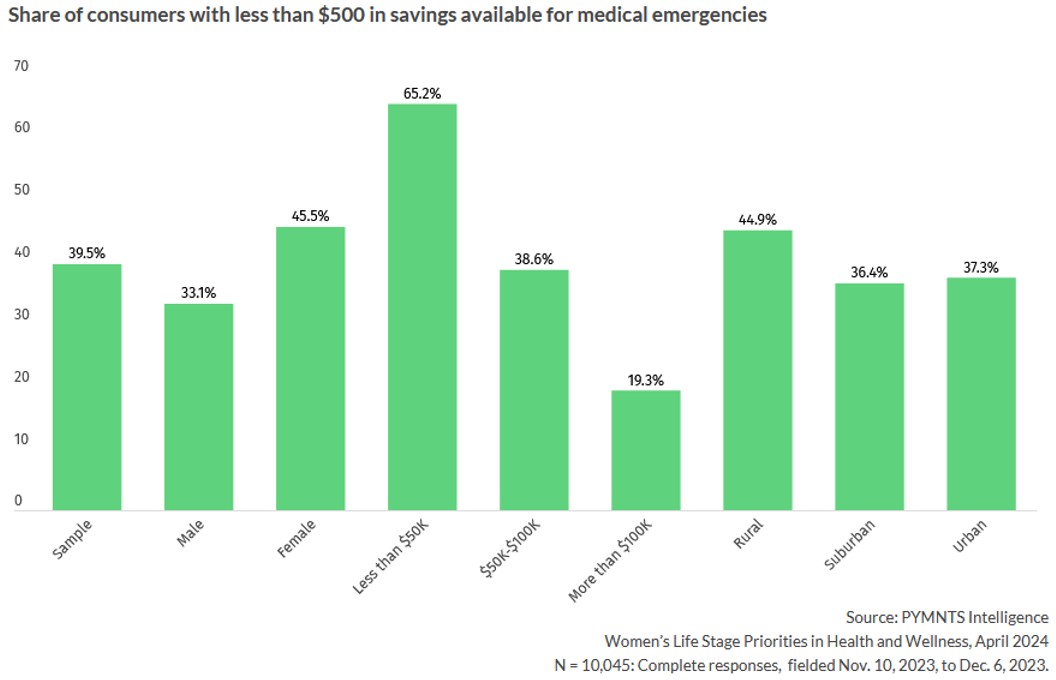
More than 6 in 10 U.S. consumers who earn below $50,000 annually have less than $500 on hand for medical emergencies — and they are nearly twice as likely than the average American to be in poor health.
These are just two key findings uncovered as PYMNTS Intelligence researched its recently released “2024 Women’s Wellness Index,” which draws on insights gleaned from surveys with more than 10,000 U.S. consumers.
It’s not just the 65% of low-income Americans who are vulnerable to unexpected medical costs; PYMNTS Intelligence found that 40% of all U.S. consumers have less than $500 earmarked for unexpected medical bills. Women are especially susceptible to unforeseen medical expenses: 46% of them have less than $500 available, while only about one-third of men do.
Meanwhile, the average cost for a trip to the emergency room in the U.S. exceeds $2,400 before insurance, according to Health System Tracker. PYMNTS Intelligence found that 7.5% of American adults are uninsured.
About one-third of urban dwellers have less than $500 set aside for sudden medical emergencies, as do 36% of suburban residents. Rural residents are even more vulnerable to unplanned medical costs: 45% of them have less than $500 at the ready.

Earning higher incomes alone does not necessarily translate into having more money stashed away for medical rainy days. PYMNTS Intelligence found 39% of consumers who earn between $50,000 and $100,000 each year have less than $500 available for medical emergencies, while nearly 20% of those earning $100,000 or more each year are in the same boat.
But even though earning more money doesn’t necessarily mean having a sufficient amount of cash stashed away for medical costs, committing to saving more expressly for that purpose does correlate with healthier lifestyles. PYMNTS Intelligence found that 80% of consumers who have set aside $5,000 or more specifically for healthcare expenses tell us they tend to take a proactive stance when it comes taking care of their health and wellness, while only 56% of those with less than $500 available said the same.
As distressing as it may be to lack the money needed to cover emergency medical costs, PYMNTS Intelligence research also reveals a corresponding trend that is equally troubling: consumers who have less than $500 available for unexpected medical emergencies are almost twice as likely to report being in poor health.
Even though most medical experts agree preventative care is key to staying healthy, one-third of low-income consumers told us they have not had access to a primary care provider in the last year because they lack the money to cover the costs of seeing a doctor.
Only about 42% of low-income earning women and 40% of corresponding men say they have been able to follow recommended medical screening schedules. (Meanwhile, 58% of high-income women and 59% of high-income men say they have followed their doctor’s recommendations.)
Perhaps most troubling of all, lacking money to cover medical costs can compound the financial woes low-income Americans already face. When asked what safety nets they would rely on should out-of-pocket medical costs exceed what they can afford, 35% of respondents said they would most likely use service provider plans that accrue interest, while 34% said they would put the expense on credit cards that also accrue interest.
Meanwhile, 9% said they would delay or forgo the treatment altogether.